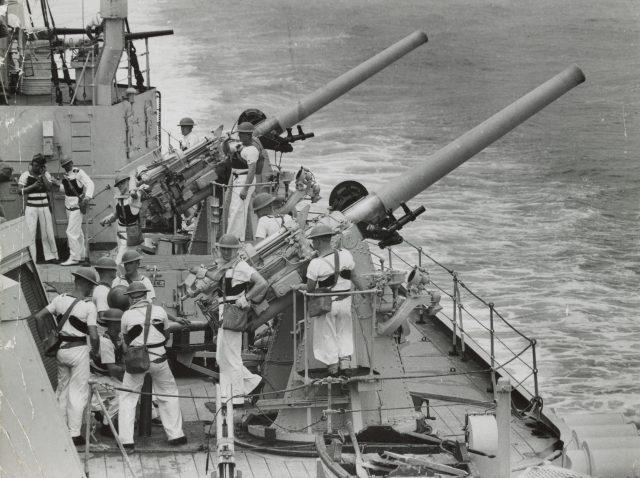
The need for Australia to have a navy (indeed an integrated defence force) to protect its supply routes, set out so directly in John Saunders’ excellent article, is worth examining as part of a broader discussion about the nation’s changing strategic circumstances.
Australia’s defence has long been based on two basic premises. The first is that we’re a long way from anyone with the capability and intent to do us harm. The second is that we’re closely allied to the world’s predominant global maritime power. Those fundamentals underpin discussions about the growth of China’s military power and global strategic weight, the US response and the implications for Australia’s strategic position.
Both Malcolm Davis and Stephan Frühling have offered compelling analyses of the potential consequences for Australia’s nuclear weapons policy and the US doctrine of extended deterrence. Both contend that China would need bases in the Indonesian archipelago to use ‘overwhelming conventional forces to invade Australia or to otherwise coerce us into submission’ or ‘to threaten Australia, at least in a sustained and substantial way’.
In many possible contingencies, this is a reasonable premise on which to base a defence force. However, as Saunders’ article demonstrates, there are also contingencies in which the traditional ‘fortress Australia’ approach would no longer work. It remains necessary, but is in no way sufficient.
Modern global trading and communications systems mean that Australia has vulnerabilities that are located well north of the archipelago. We need to consider if force could be used against those in a way that could coerce or threaten Australia without the need to directly attack our territory.
Uniquely and easily identifiable Australian interests—particularly shipping and communications—are located far beyond the archipelago to our north. Or they’re accessible via physical supply chains or cyber means from locations well beyond the archipelago. In many cases our neighbours, friends and allies share similar concerns, but in others their worries are quite different or don’t have the same level of importance. The relatively small number of finger‑width submarine cables connecting Australia is one example.
Shipping is another. Ocean passages of the world shows the routes most commercial shipping uses. Port websites such as Yokohama or Melbourne and shipping apps using automatic identification system information provide even more detailed, accurate and near real-time information about our national economic arteries. An aggressor wouldn’t have to come south of the archipelago to target them.
Australia’s commitment to global trade means that disruptions to the trading system have significant effects on us. In some cases we’re very sensitive to even short disruptions. Australia’s dependence on petroleum imports is well known. In 2016–17, Australia had stocks of unleaded, diesel and aviation turbine fuel to meet demand for 23, 17 and 20 days.
Given our dependence on global communications, finance and trade, conventional forces could put enormous pressure on Australia from great distances beyond the archipelago. The effects could be rapid, targeted, scalable and sustained over weeks and months. Such pressure might not engage the interests of other nations sufficiently for Australia to be able to depend on their assistance.
Put simply, we are much closer to the rest of the world (both in a physical sense and in cyberspace), and disruption to our connections would affect us faster and harder than in the past.
Direct assault on a fortress was and is never a first preference. Siege tactics of various types—bypassing, isolating, island-hopping—are preferable. So while we must be prepared to defend the Australian fortress, we must also understand the vulnerabilities that could lead to the fortress submitting without direct assault.
This isn’t to suggest that Australia’s alliance with the United States is diminished in any way. If anything, I believe the contrary. But it does mean that the traditional first premise of Australian defence strategy—that we are a long way away—is no longer true in many circumstances.
This has implications for the way in which we conduct our diplomacy in the region, and in the way that we structure the Australian Defence Force (ADF). The basic approach is emerging—an integrated defence force across sea, land, air, cyber, space and industry. But many of the cultural, doctrinal and familiar approaches will need to evolve if the ADF is to be as effective as necessary.
It might be that our cyber capabilities will need to feature much more prominently. Or that our land forces will need to be far more comfortable operating at and from the sea. Or that our submarines will have to be more closely integrated into other Defence elements to achieve greater effects at the strategic, operational and tactical levels. Or that we need to revisit the discussion about fixed-wing aircraft at sea, perhaps as part of what Richard Menhinick suggests should be a larger, more potent maritime force.
More likely still, we will need to do all of these things and more. We must challenge ourselves to avoid the pre–World War I malaise of Great Britain’s military leaders described by Max Beloff:
But their service training had not inculcated that rare kind of imagination which enables men to plan not just for the exploitation of the existing state of their art but for its future developments also … It was then neither intelligence nor character that failed Britain, but imagination, the ability to see facts afresh without professional blinkers.
In an assessment of military effectiveness, Paul Kennedy concluded that if an organisation—or country—shrinks from encouraging imagination, ‘it is unlikely to maintain its military effectiveness for long, or even to be very effective in the first place’.